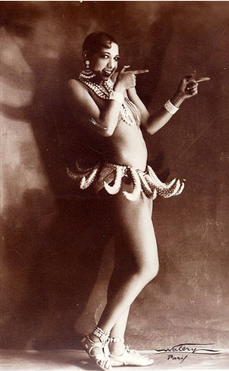
Mention Josephine Baker today though and most people will think banana dance. A joyful thought, I agree, however there is more than just a banana dance to Baker.
At the age of 8 Baker was sent to work for a white woman who was abusive towards the child. Once, as punishment for putting too much soap in the laundry, the woman burned Baker’s hands. It isn’t surprising that when Baker was 12 she left school and such employment and became a street child in the slums of St. Louis. Surviving on what she could scavenge from bins and sleeping in cardboard boxes Baker was spotted street corner dancing. After a short lived marriage at 13 to Willie Wells and a stint at 15 in the St. Louis Chorus Vaudeville show Baker headed for New York.
It was in New York that Baker found her feet (but not her steps) as the traditional ‘last dancer’ in the chorus line. The last dancer provided comedy by spending the show not quite being able to get the dance steps right. By the encore though the last dancer doesn’t just get the steps right, but performs them with extra panache and choreography. It was this routine that earned Baker billing as “The highest paid chorus girl in vaudeville”. But the city of New York was not where Baker was to peak in her career.
In 1925 Baker arrived in Paris to perform in La Revue Nègre at the Théâtre des Champs-Élysées. Her erotic dancing (there are some great letters between various 1920s/30s personalities raving about this ‘stomach dance’) and skimpy wardrobe took Paris and then Europe by storm. Baker’s Danse Sauvage and the accompanying stage costume of artificial bananas was a hit, Baker later said of the act: “Since I personified the savage on the stage, I tried to be as civilized as possible in daily life.”
Paris embraced Baker, “…I realised I was living in a country where I was afraid to be black. It was only a country for white people. Not black. So I left. I had been suffocating in the United States... A lot of us left, not because we wanted to leave, but because we couldn't stand it anymore... I felt liberated in Paris.” During this success Baker became a muse to artists and writers such as Picasso, F. Scott Fitzgerald and Dior. She took as lovers the artist Frida Kahlo, Colette and Ada “Bricktop” Smith. Baker had a hit song with J'ai deux amours and starred in the films Siren of the Tropics, Zouzou and Princesse Tam Tam.
Becoming a French citizen in 1937 Baker proved her loyalty to her adopted country by staying in Paris at the outbreak of war. The French Government asked her to work for them as an honourable correspondent (or spy). Reporting anything she heard at parties that might be of any use to the government. Baker attended parties at the Italian Embassy and reported back the information given to her by the Japanese officials and Italian bureaucrats at these events.
Eventually, as the Germans invaded, Baker had to leave Paris. She fled to her chateau in the south of France where she sheltered Belgian refugees. Baker was one of the few people who had good reason to travel. As an entertainer it was not suspicious for her to tour neutral countries such as Portugal and Baker took advantage of this, passing on secrets written in invisible ink on her sheet music.
This and other brave activities for the French Resistance earned Baker the Croix de guerre and the Rosette de la Résistance. General Charles de Gaulle also recognised her achievements, making Baker a Chevalier of the Légion d'honneur. How many chorus girls have had that on their CV?
Baker’s huge energy and passion for resistance and political change did not lose momentum. Baker was a great force in the Civil Rights movement in the 1950s, refusing to perform for segregated audiences and adopting 12 children of various ethnic origins which she called The Rainbow Tribe. Working with the NAACP Baker was the only woman to speak officially at the 1963 March on Washington with Martin Luther King, Jr. She wore her Free French uniform and her Légion d'honneur medal. Later, after the assassination of Martin Luther King, Jr. his widow Coretta Scott King invited Baker to take her husband’s place as leader of the American Civil Rights Movement. Baker declined, fearing her Rainbow Tribe might be left prematurely motherless.
In 1975, after a starring in Joséphine à Bobino 1975 a retrospective revue celebrating Baker’s 50 years in show business, Baker was found lying in bed surrounded by gushing newspaper reviews of the revue. She was 68. Baker had predicted the manner in which she would die, “I love performing. I shall perform until the day I die.”
Baker should be remembered not just as a performer but also a spy and civil rights activist. Oh go on then, here’s the banana dance.
 RSS Feed
RSS Feed
